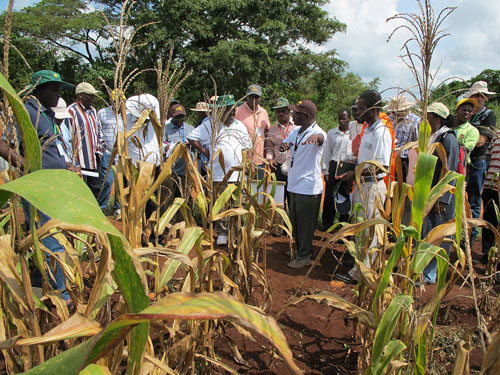 Over 200 researchers, policy makers, donors, seed companies, and NGO representatives from Africa and Australia gathered in Chimoio, Mozambique, during 17-23 March 2013 for the third SIMLESA (Sustainable Intensification of Maize-Legume Systems for Food Security in Eastern and Southern Africa) annual regional planning and review meeting to discuss the project’s progress and achievements, share lessons learned throughout the last three years, and deliberate over better ways to design and implement future activities in the SIMLESA target (Ethiopia, Kenya, Tanzania, Malawi, and Mozambique) and spillover countries (Botswana, Uganda, South Sudan, and Zambia).
Over 200 researchers, policy makers, donors, seed companies, and NGO representatives from Africa and Australia gathered in Chimoio, Mozambique, during 17-23 March 2013 for the third SIMLESA (Sustainable Intensification of Maize-Legume Systems for Food Security in Eastern and Southern Africa) annual regional planning and review meeting to discuss the project’s progress and achievements, share lessons learned throughout the last three years, and deliberate over better ways to design and implement future activities in the SIMLESA target (Ethiopia, Kenya, Tanzania, Malawi, and Mozambique) and spillover countries (Botswana, Uganda, South Sudan, and Zambia).
“SIMLESA had attained a ‘steady flight path’ and is on track to deliver significant impacts,” noted Derek Byerlee, Program Steering Committee (PSC) co-chair, and the Mid-Term Review (MTR) conducted last year supports his words: “The MTR Team has reviewed progress by objectives and the overall execution of the Program, and finds that in general it has made very good progress in its first two years.” Bekele Shiferaw, Program Management Committee chair, then highlighted MTR’s recommendations, including the following: SIMLESA should take concrete steps to overcome current socio-economic research capacity constraints in national agricultural research systems and in the areas of value chains, informal analyses, business management, participatory agronomy, and breeding research; focus on ‘smart’ sequences for testing conservation agriculture technologies with farmers resulting in step-wise adoption; and create representative and effective innovation platforms with clear roles, structures, and functions.
As SIMLESA Phase I is ending next year, participants brainstormed on key issues anticipated in Phase II, concluding that the overall approach should be holistic, flexible in dealing with complex systems, and should aim to devise effective ways to target different group of farmers, as one size does not fit all. Furthermore, it was noted that Phase II should focus on changing the mindset of farmers. “There are so many different technologies bombarding farmers. The real work therefore lies in dealing with the psychological, social, cultural, and environmental factors of the farmer that will determine the adoption of introduced technologies,” noted one of the participating groups during the plenary session. Following the discussion on Phase II, Byerlee shared PSC’s vision: apply a broader approach to system intensification (conservation agriculture elements, soil fertility, pest management, and diversification); be more country specific; create empowering, location-specific, and sustainable innovation platforms; and pay more attention to institutions and policies vis-à-vis technology.
In the words of Inacio Maposse, Agricultural Research Institute of Mozambique (IIAM) director general and PSC member, Phase II is not necessary only because Phase I is ending but also “because we want to add another dimension to the program, and perhaps a different philosophy, one that will lead us to success. And for me, success means to get farmers smile sustainably. Smile because they are better off. For this to happen, we have to design Phase II with heart and wisdom. We need Phase II because we are yet to produce significant adoption and impact on the farming communities.” John Dixon (senior advisor for cropping systems and economics and principal regional coordinator for Africa and South Asia, Australian Centre for International Agricultural Research) added another reason for why to continue with SIMLESA: “Where resources are limited, sustainable intensification is the only option to feed the extra two billion people by 2050.”
Mellissa Wood, Australian International Food Security Centre (AIFSC) director, then explained some of the reasons behind the close cooperation between Australia and Africa: “Australia and Africa share many common agricultural challenges, including limiting soils, highly variable climates, pests, and diseases.” Consequently, AIFSC aims to accelerate adoption; bridge the gap between research and development; find new ways to support African agricultural growth through adoption, policy, scale-out, improved market access, diversification, and nutrition.
In her closing remarks, Marianne Bänziger (CIMMYT deputy director general for research and partnerships) called on the Phase II planners to design holistic packages that entail success and ensure SIMLESA provides farmers in the five target countries with diverse opportunities for improving their livelihoods. “Farmers should be able to get incomes not only from maize and legumes but also from other farm enterprises. You should come up with possible and realistic interventions in realistic time frames,” Bänziger concluded.
Throughout the meeting, implementing partners, researchers, and seed companies showcased their achievements and products at the ‘SIMLESA poster village.’ Participants learned about farmers’ perspectives and practices through field visits to Sussudenga maize breeding and exploratory trial sites, participatory variety trials in Vanduzi and Polytechnic Institute of Manica, and conservation agriculture and innovation platforms scaling out sites in Makate.
 Climate adaptation and mitigation
Climate adaptation and mitigation